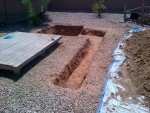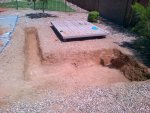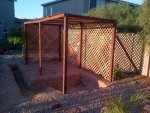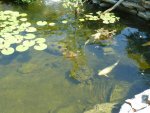I assume the liner is placed first, then the mortared rocks are on top of that.
Yes.
That should cause very small spaces between the liner and mortar.
Definitely. From the freeze thaw perspective I would even say the spaces are large. Lots of large air bubbles between the mortar and liner can be seen when I've torn down such a pond. So plenty of voids for water and ice to get into.
I'm sure those spaces are not water tight and that some water will seep in.
Correct.
While it might not happen right away, I can't imagine that you wouldn't wind up seeing the mositure trapped in some of these tiny spaces in here and freezing.]
Absolutely true. I don't see how it would be possible to ever not be true.
Over a few years, I'm sure that would eventually takes it's toll on the mortar, (at least the stuff in the freeze zone near the top). Mortar itself is not waterproof and will soak in water which can also get trapped and freeze. Almost microscopic but over time it will take its toll on the mortar.
Water can take a toll on mortar reducing life span to a few years if acid enough. In a normal pond water can reduce life span to the 20, 30, 50 year range depending on the thickness and other factors like a muck layer that would be acidic.
will soak in water which can also get trapped and freeze.
That's the misconception,
trapped. Freezing is only an issue in enclosed spaces. If water can soak into a void under no pressure...it can also soak out, especially when under pressure. Again, concrete sidewalks in winter before a freeze may have many (billions) of small openings completely full of water. As the ice forms molecule by molecule and pressure increases and liquid water molecules are push out of the voids. The result is an opening completely filled with ice, no pressure, and no breakage.
Anyone can put a chunk of mortar or concrete into a container of water and place it into their freezer. No damage. Repeat as often as desired, no damage.
Where there would be a problem is if a cement vessel was formed, filled with water and frozen. Flower pots for example can break if full of wet soil and freezes.
Certainly I can see that in billions of applications of cement in freezing climates around the world that there must be cases where ice formed in the perfect storm that there's been damage. Concrete foundations in many areas are submerged in water (like NY where I grew up the water table was at ground level in winter) and freeze without damage for decades (my boy hood home is 101 years old and still has no problem). Thousands of gunite pools in freezing climates submerged in water (from the outside) seem to be OK. Many, many examples.
I could never recomend that to anyone in our area and feel confident about it. In the more temperate climes it might be fine for 20-30 yrs.
A very good idea imo to never recommend things you don't feel comfortable with. However, the more you learn, the more comfortable you can become in engineering solutions. It's been my experience in both software, pond and other stuff that those jobs pay way better. So for me it's been worth the research.
Back years ago I had many discussions in pond forums describing options in freezing climates. It was fine, but I doubt I ever changed anyone's mind on the subject. It's just one of those things that sticks in most people's minds even if they're surrounded by frozen cement products in and around the home, at work, at stores, everywhere. So these days I rarely even talk about making rocks or mortared rock because it doesn't really help anyone. Those interested enough can certainly find enough info on the subject. Not exactly like I'm the first person to ever say cement can last in freezing submerged conditions.








